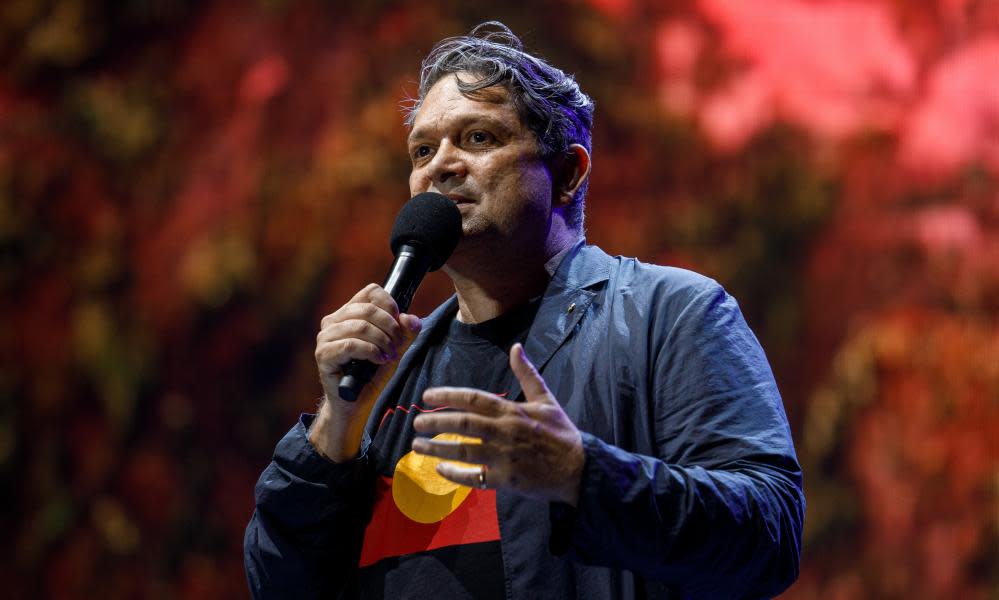Dropping plans for Indigenous cultural centre at Barangaroo a ‘backward’ step, Aboriginal leaders say

The New South Wales government has come under fire for its decision to cancel plans for an Indigenous cultural centre at Barangaroo’s enormous Cutaway site.
A number of feasibility studies and concept designs had been undertaken on the proposal for the subterranean landmark site, housing almost 5,500 sq metres of space. Wesley Enoch, an artist and playwright, and Rhoda Roberts, the head of Sydney Opera House’s Indigenous programming for nearly a decade, were among the First Nations arts leaders involved in the project.
The decision by the government to scrap the plans has been criticised by Enoch, who had been tasked with investigating the proposal.
The standalone dedicated Indigenous cultural centre was to form part of the state government’s multibillion-dollar plans to revitalise the waterfront precinct.
The cavernous property had played host to a number of cultural events, exhibitions and performances while more permanent proposals were considered
Enoch said the decision was shortsighted, backward and tantamount to colonial ways of engaging with Indigenous peoples and communities.
“This was 30 years of ambition; it’s very disappointing for the entire community,” the Quandamooka man told Guardian Australia.
He said a lot of work to ensure different Indigenous communities and perspectives were included in the scoping of the project had already been undertaken.
“We did a lot of work in terms of design and community consultations,” he said. “We have to bring a whole community along in the process and Black processes take longer and they are more in depth to engage in that debate and discussion.
“Sometimes the white decision-makers, the white bureaucracy and the powers that be in those structures just aren’t equipped to deal with us and our ways.”
He said the city risked damaging its reputation as other states and territories made moves to create dedicated Indigenous cultural precincts in South Australia, the Northern Territory, Queensland and, most recently, Western Australia.
“Sydney was the leader in that conversation over 30 years ago and now it’s slipped back … it’s just one of those huge missed opportunities,” Enoch said.
He said the centre could have been a drawcard for tourists, Sydneysiders and Indigenous peoples to come together and unite in a dedicated space celebrating Indigenous culture, art and history.
“It could have been a real point of pride, celebrating and promoting Indigenous storytelling of the city to its own citizens as well as others,” Enoch said.
Email: sign up for our daily morning briefing newsletter
App: download the free app and never miss the biggest stories, or get our weekend edition for a curated selection of the week's best stories
Social: follow us on YouTube, Facebook, Instagram, Twitter or TikTok
Podcast: listen to our daily episodes on Apple Podcasts, Spotify or search "Full Story" in your favourite app
Infrastructure NSW said in a statement that the Cutaway site would still “accommodate” First Nations cultural events and exhibitions.
“The decision to progress with the Cutaway as a flexible multi-purpose space was a decision of the NSW Government, following a three-phase investigation and consultation process into potential opportunities for the Cutaway,” a spokesperson for the department said.
“Connecting with Country is a strong attribute of the design proposals currently being prepared for the fit-out of the Cutaway.”
Earlier this year, the government announced the Museum of Sydney, the site of Australia’s first Government House, would be transformed into an Indigenous cultural space dedicated to the culture and history of Aboriginal people.
Enoch said a proposed centre at the Museum of Sydney in the former Government House was not enough and had its own past to consider.
“We are beyond the days where First Nations Australians should be grateful … and that site is also a significant site of colonisation,” he said.

 Yahoo News
Yahoo News 